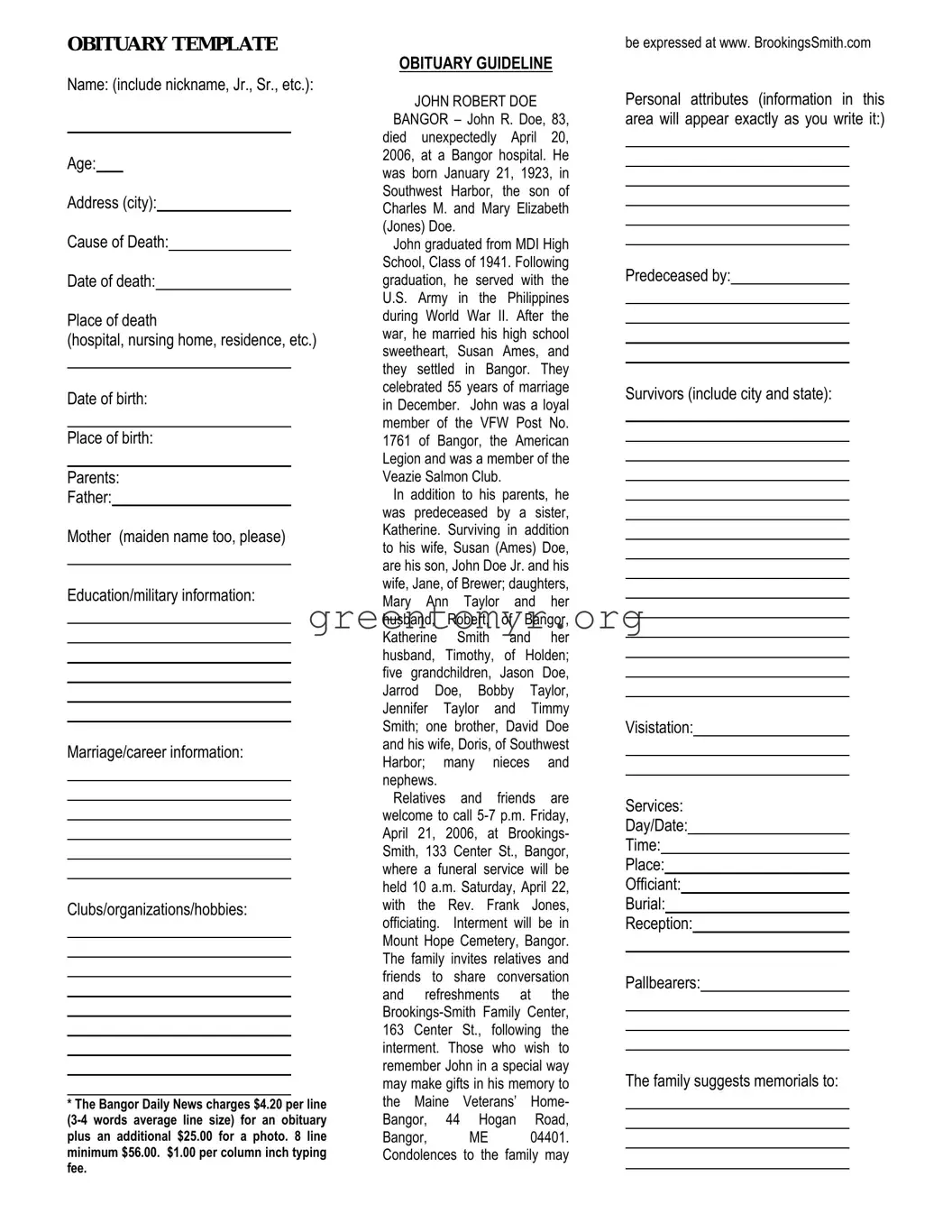OBITUARY TEMPLATE
Name: (include nickname, Jr., Sr., etc.):
Age:
Address (city):
Cause of Death:
Date of death:
Place of death
(hospital, nursing home, residence, etc.)
Date of birth:
Place of birth:
Parents:
Father:
Mother (maiden name too, please)
Education/military information:
Marriage/career information:
Clubs/organizations/hobbies:
*The Bangor Daily News charges $4.20 per line (3-4 words average line size) for an obituary plus an additional $25.00 for a photo. 8 line minimum $56.00. $1.00 per column inch typing fee.
OBITUARY GUIDELINE
JOHN ROBERT DOE
BANGOR – John R. Doe, 83, died unexpectedly April 20, 2006, at a Bangor hospital. He was born January 21, 1923, in Southwest Harbor, the son of Charles M. and Mary Elizabeth (Jones) Doe.
John graduated from MDI High School, Class of 1941. Following graduation, he served with the U.S. Army in the Philippines during World War II. After the war, he married his high school sweetheart, Susan Ames, and they settled in Bangor. They celebrated 55 years of marriage in December. John was a loyal member of the VFW Post No. 1761 of Bangor, the American Legion and was a member of the Veazie Salmon Club.
In addition to his parents, he was predeceased by a sister, Katherine. Surviving in addition to his wife, Susan (Ames) Doe, are his son, John Doe Jr. and his wife, Jane, of Brewer; daughters, Mary Ann Taylor and her husband, Robert, of Bangor, Katherine Smith and her husband, Timothy, of Holden; five grandchildren, Jason Doe, Jarrod Doe, Bobby Taylor, Jennifer Taylor and Timmy Smith; one brother, David Doe and his wife, Doris, of Southwest Harbor; many nieces and nephews.
Relatives and friends are welcome to call 5-7 p.m. Friday, April 21, 2006, at Brookings- Smith, 133 Center St., Bangor, where a funeral service will be held 10 a.m. Saturday, April 22, with the Rev. Frank Jones, officiating. Interment will be in Mount Hope Cemetery, Bangor. The family invites relatives and friends to share conversation and refreshments at the Brookings-Smith Family Center, 163 Center St., following the interment. Those who wish to remember John in a special way may make gifts in his memory to the Maine Veterans’ Home- Bangor, 44 Hogan Road,
Bangor, ME 04401. Condolences to the family may
be expressed at www. BrookingsSmith.com
Personal attributes (information in this area will appear exactly as you write it:)
Predeceased by:
Survivors (include city and state):
Visistation:
Services:
Day/Date:
Time:
Place:
Officiant:
Burial:
Reception:
Pallbearers:
The family suggests memorials to:

